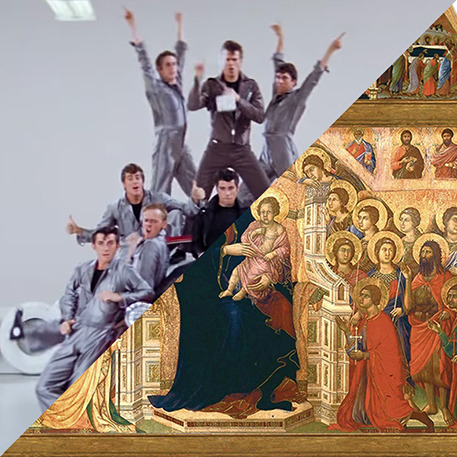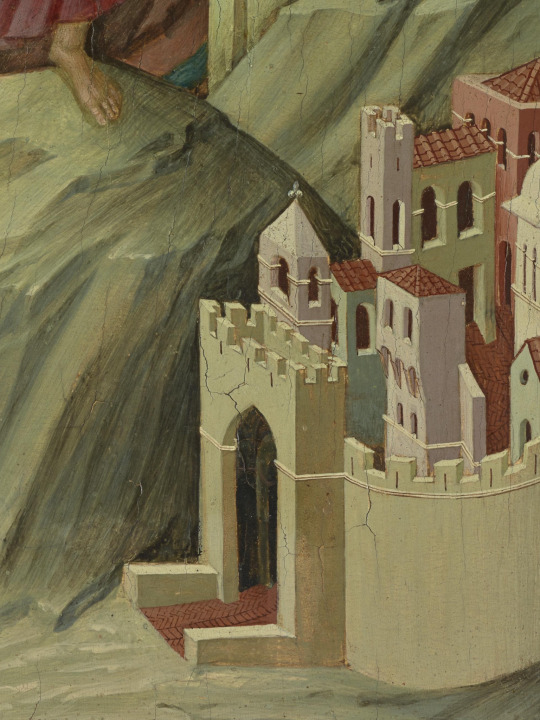#duccio di buoninsegna
Explore tagged Tumblr posts
Text

The Raising Of Lazarus
Artist: Duccio di Buoninsegna (Italian, 1255–1319)
Date: c. 1310–1311
Medium: Tempera and gold on panel
Collection: Kimbell Art Museum, Fort Worth, Texas, United States
Description
Duccio was the preeminent Sienese painter in the early years of the fourteenth century. He infused the prevailing Byzantine style with a more naturalistic, narrative mode. The Kimbell painting originally formed part of the altarpiece known as the Maestà (Majesty), made for the high altar of Siena Cathedral. The Maestà was among the most beautiful and complex altarpieces ever made. Some sixteen feet in height, it was painted on both sides, the front showing the Madonna and Child enthroned with saints and the rear showing episodes from the life of Christ. The front predella (a boxlike base) depicted events from Christ’s childhood, and the back predella recounted his ministry.
The Kimbell Raising of Lazarus was most likely the final scene of this back predella, providing the climactic proof of Christ’s divinity, when he brings a man back from the dead. The Gospel according to John 11:1–44 tells how when Lazarus fell ill, his sisters Martha and Mary sent for his friend Jesus. By the time Jesus arrived in Bethany, Lazarus was already dead four days. Duccio shows the moment when Jesus called Lazarus forth from the tomb, prefiguring his own Resurrection.
A noteworthy compositional change is apparent at the lower right. The paint surface, thinned by age, reveals an underlying paint layer showing a horizontal sarcophagus.
This and several other panels became separated from the Maestà after it was dismantled in 1771. Most of the panels are today in the Siena Cathedral museum.
#christianity#biblical scene#biblical story#the raising of lazarus#tempera and gold#painting#artwork#men#women#jesus#mary#martha#lazarus#tomb#resurrection of lazarus#art and the bible#christian art#italian culture#italian art#Duccio di Buoninsegna#italian painter#european art#kimbell art museum#14th century painting
9 notes
·
View notes
Text

Duccio di Buoninsegna από τη Σιένα - Η ανάσταση του Λαζάρου (λεπτομέρεια), 1310–11 / [***]
11 notes
·
View notes
Text

Duccio: A Virxe co Neno
7 notes
·
View notes
Text

the eight surviving rear predella panels of Duccio's Maestà, showing scenes from the life of Christ, reunited at the Metropolitan museum until late January 2025.
5 notes
·
View notes
Text

The Incredulity of Saint Thomas (from the Maesta Altarpiece), Duccio, 1308
#Eastertide#art#art history#Duccio#Duccio di Buoninsegna#religious art#Biblical art#Christian art#Christianity#New Testament#Gospels#Saint Thomas#Doubting Thomas#Middle Ages#medieval#medieval art#Gothic art#International Gothic#Italian Gothic#Trecento#Italian art#14th century art
111 notes
·
View notes
Photo

Randal Kleiser, Grease, 1978 VS Duccio di Buoninsegna, Maestà, 1308-1311
#Randal Kleiser#movie#cinema#grease#film#musical#duccio di buoninsegna#duccio#maestà#siena#Scuola senese#gothic#middle age#italy#tuscany#toscana#paint#paintin#altarpiece#duomo di siena
55 notes
·
View notes
Text

Oggi in molti paesi di lingua spagnola è il giorno delle "inocentadas".
Qualcosa come il nostro pesce d'aprile. Un giorno in cui si fanno scherzi di ogni tipo ricordando gli innocenti vittime della crudeltà di Erode.
A scherzo consumato, il burlone canzona il burlato con frasette di questo tipo:
¡Inocente!
¡Caíste por inocente!
¡Qué la inocencia te valga!
Tutte espressioni che sottolineano che la vittima ci è caduta in quanto credulone e... innocente.
La rappresentazione della strage degli innocenti che vedete qui sopra è una tempera su tavola di Duccio di Buoninsegna tratta dal polittico "Maestà del Duomo di Siena", 1308-1311.
2 notes
·
View notes
Photo

Pilate washing his hands, detail from Episodes from Christ's Passion and Resurrection, reverse surface of Maesta' of Duccio Altarpiece in the Cathedral of Siena by Duccio di Buoninsegna
#Duccio di Buoninsegna#Buoninsegna#pilate#washing#christ#christi#christian#jesus#jesus christ#holy bible#bible#church#religion#cathedral#siena#cathedral of siena#altar#passion#art#artwork#painting
12 notes
·
View notes
Text

Jean Paris ha illustrato il funzionamento di questi poli nella pittura, dal Cristo dispotico al Cristo passionale: da una parte, il viso del Cristo visto di faccia, come in un mosaico bizantino, con il buco nero degli occhi sul fondo dorato, mentre tutta la profondità sembra proiettarsi in avanti; d’altra parte, i visi che s’incrociano o si voltano, di tre quarti o di profilo, come in una tela del Quattrocento, con sguardi obliqui che tracciano linee molteplici ed integrano la profondità nel quadro stesso (si possono prendere esempi arbitrari di transizione e di mescolanza: la Vocazione degli Apostoli, di Duccio, su paesaggio acquatico, in cui la seconda formula prevale già nel Cristo e nel primo pescatore, mentre il secondo pescatore resta preso nel codice bizantino).
Gilles a Deleuze & Felix Guattari, Anno zero, viseità
4 notes
·
View notes
Text

The Miraculous Catch of Fish and the Calling of the Apostles Peter and Andrew
Artist: Duccio di Buoninsegna (Italian, c.1260- c. 1318–1319)
Genre: Religious Art
Date c. 1308-1311
Medium: Tempera on Wood
National Gallery of Art, Washington, DC
Jesus Calls Peter and Andrew | Matthew 4:1822
Jesus was walking by the Sea of Galilee. He saw two brothers. They were Simon (his other name was Peter) and Andrew, his brother. They were putting a net into the sea for they were fishermen. Jesus said to them, “Follow Me. I will make you fish for men!” At once they left their nets and followed Him.
Going from there, Jesus saw two other brothers. They were James and John, the sons of Zebedee. They were sitting in a boat with their father, mending their nets. Jesus called them. At once they left the boat and their father and followed Jesus.
#religious art#fish#net#apostle peter#apostle andrew#jesus#sea of galilee#new testament#gospel of matthew#14th century painting#tempera on wood#duccio di buoninsegna#christian art#christianity#italian painter
11 notes
·
View notes
Text

Duccio di Buoninsegna, The Temptation of Christ on the Mountain (detail), 1308—1311
5 notes
·
View notes
Text
100+ Famous Modern Art Artists of All Time

2/8/2024 ♦ Framed Poster Print ♦ Canvas Print ♦ Metal Print ♦ Acrylic Print ♦ Wood Prints 🌐 Worldwide shipping
#Claude Lorrain#sandro botticelli#jenny saville#mark rothko#francisco de goya#marcel duchamp#andrea mantegna#frans hals#paul klee#Hans Holbein#fra angelico#willem de kooning#david hockney#max ernst#tintoretto#jasper johns#umberto boccioni#duccio di buoninsegna#Rogier van der Weyden
4 notes
·
View notes
Text

Retabel
Das Retabel ist eine Tafel, die retabliert, also dasjenige tut, was nach Walter Benjamin die Form des Kommentars mit dem Geheimnis phasenweise macht. Was ein Geheimnis ist? Das ist u.a. ein Schreiben, allgemein sind Geheimnisse (choreo-)graphische Akte(n), die durch Sekretariate gehen, also auch dank der Sekretariate vorgehen, Vorgänge bilden können. Retablieren ist wiederholtes, wiederholendes, in Warburgs Sinne nachlebendes und dabei kehrendes Tafeln. Selbst wenn im Kehren das Selbe wiederkehrt, bleibt es polar und vage und darum auch schwer kalkulierbar bis unberechenbar. Man kann trotzdem rational, routiniert oder technisch damit umgehen: Warburg macht es ja.
Wie Tafel 78, so hat auch Tafel 79, die zweite der Staatstafel, eine Initiale, sie besteht hier aber nicht aus einem Bild, sondern drei Bildern in der oberen linken Ecke der Tafel. Warburg legt diese Tafel nicht wie Tafel 78 an, er legt sie nicht als diplomatisches Protokoll eines diplomatischen Protokolls an. Er legt diese Tafel als Kommentar an. Die Initiale zeigt dabei drei Bilder eines, des selben Gegenstandes, einmal davon in einem und durch ein Retabel verhüllt, das Retabel von Bernini in St. Peter. Weil eine der Vertragsparteien der heilige Stuhl ist, wählt Warburg Bilder eines Stuhls, nicht des heiligen Stuhls (dessen Repräsentation im Lateranpalast steht). Warburg wählt einen Lehrstuhl (catedra petri), wenn man so will: den Stuhl einer venia legendi. Wenn man weiter so will: den Stuhl eines venerischen Gerüchtes, also venerischen, normativen Materials. Warburg denkt sich was dabei, er wählt einen Stuhl, der ein Polobjekt ist, weil an seiner Vorderseite, wie auf den Staatstafeln', Tafeln hängen, deren Vorbilder Sternenbilder sind, die also Bewegung möglich machen sollen, vor allem die letzten beiden Schritten in Warburgs Sortierung: die Orientierung und die Aktion, das Handeln. Er wählt also einen Stuhl, der seinem Interesse an Bildern exakt entspricht, er macht das als der Polarforscher, der er nunmal ist.
Der Stuhl wird über die Tafel gezogen, kehrt als kurulischer Klappstuhl, also als Polobjekt des römischen ius imaginum einmal in hohem Stil, also sublim und nahe am Souverän, nämlich in Raffaels Bild wieder auf, an ihm kniet Julius II. Und oops, he did it against, noch einmal kehrt der Stuhl wieder, wieder als Klappstuhl, aber diesmal in einem niederen, subtilen Stil, weit entfernt vom Souverän, aber dafür nahe an den Leuten, nach denen Leute wie Laokoon schauen müssen, weil an ihnen immer etwas absteht. Als Campingstuhl von Touristen taucht der Stuhl, der in der Initiale drei mal gezeigt wird, auch der Sache nach drei mal auf der Tafel auf.
2 notes
·
View notes
Text

Jesus fühlte rein und dachte
Nur den Einen Gott im Stillen;
Wer ihn selbst zum Gotte machte
Krdnkte seinen heil'gen Willen.
Und so mu_ das Rechte scheinen
Was auch Mahomet gelungen;
Nur durch den Begriff des Einen
Hat er alle Welt bezwungen."
Jesus felt pure and thought
Only the One God in silence;
Who made him a god himself
Confirmed his holy will.
And that's how the right thing must seem
What Mahomet also achieved;
Only through the concept of the One
He has conquered all the world."
0 notes

